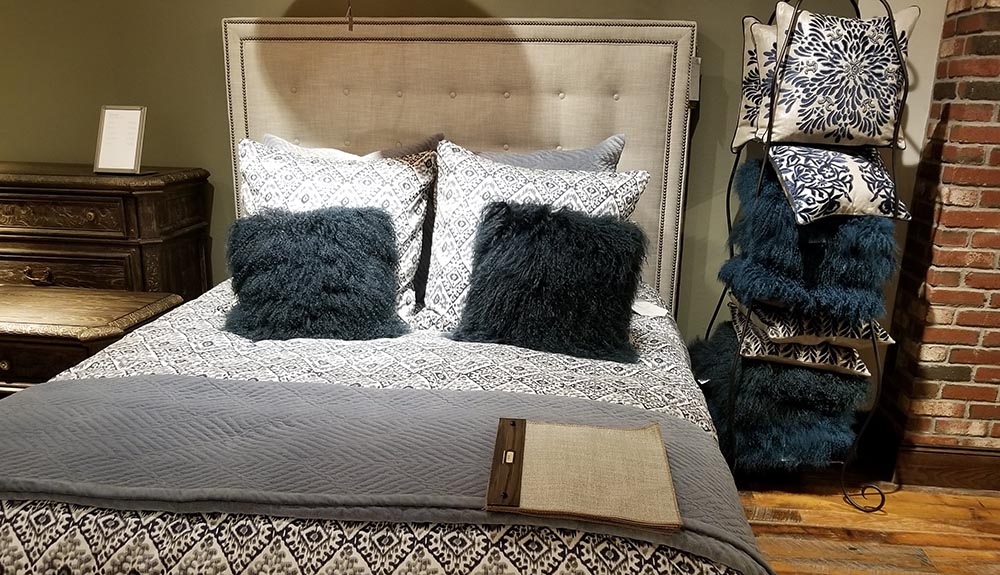“To-The-Trade” interior design showrooms are increasingly opening their doors to consumers
and more retail sporting To-The-Trade programs.
Design centers have enjoyed a reputation of being only for the well-heeled, which at one time may have been quite true. Stringent policy existed that insisted design centers were only for preregistered interior designers and architects, commonly referred as the design “trade.” But times have changed, and we are seeing a blurring of lines. Most of today’s centers not only welcome but encourage, the public to visit and peruse the many showroom offerings. As well, many of the Retail establishments offering Trade programs are expanding their in-house services.

The Trade Experience
The difference upon entering a trade only showroom is immediately noticeable. There is a distinct difference in the displayed furnishings in trade showrooms. Although there will often be vignettes displayed to display products, you will find many binders and samples suggesting an almost insurmountable supply of styles, colors, and finish options.
The level of knowledge found within trade showroom also extends to its sales staff. The sales staff are there to not only sell but to help the client make the right choices for the desired application. They are highly familiar with the lines they carry, lead times (time until delivery), as well as manufacturing details and quality of workmanship. The Trade showroom may be an occasion for the design novice to shop like a pro, but that doesn’t mean the design trade doesn’t get a benefit in their shopping options.

The Evolution of Retail
Retail showrooms have also gone through an evolution in recent years. To encourage the design trade to consider retail shopping sources, such outlets are presenting expanded fabrics offerings and customizations not previously available. We are also seeing presentation services such as floor plan and color board preparation offered to trade professionals. Retail consumers also benefit by having more options at their fingertips either directly through the store sales staff or their personal designer.

Tips of the Trade
Trade showrooms are scattered throughout the Phoenix Metropolitan area, but most can be found neighboring the Scottsdale Design District or Scottsdale Design Center. Visit their respective websites to research the available showrooms or the LuxePros directory, which features many of valley trade sources. Since not all trade showrooms allow the public to enter without a designer, check the specific showroom pages to see their visitation terms and hours. Although each Trade showroom has its own entrance policy, all will require you to sign in and many may require appointments and only allow retail traffic on certain days of the week.

Trade showrooms contain many more options than retail outlets. If you don’t have time to literally search through hundreds of brands, take advantage of the showroom’s in-house sales consultants. “We often have retail clients come in with a Pinterest photograph,” requesting to duplicate a favorite look says Roxanne Silva, Design Consultant, Facings of America. Sales consultants are there to help point you in the right direction to achieve your vision. Roxanne suggested having a set budget in mind as the price points vary greatly from manufacturer to manufacturer, “We can save you time by steering you to sections of the showroom that will keep you on track.” Not sure what you want? Roxanna suggests a simple showroom tour as a great start to “loving the space you live in.”
One on one time with a consultant is possible but make sure to always make an appointment ahead of time if you need that level of service. A trade showroom is not like a typical retail outlet as they do not have staff specifically assigned to the floor. Many of the sales take place behind the scenes via phone calls, emails, or fax and although things seem quiet, they are never unproductive and on-site staff is actively processing sales.

Tips to the Trade
Although designers use their product knowledge and expertise to help you make informed choices, well-laid plans can go quickly awry in a wholesale showroom because of the many choices.
Shelly Wyatt, Facings Design Consultant, stated the most important bit of advice she could offer a design professional is “to communicate all needs ahead of time” to the showroom consultant. Shelly suggests making it a practice to schedule a visit to the showroom prior to bringing in your client. Using this time to retrieve and lay out choices that reflect the design concept. As well as selecting a few alternate choices to give the client the opportunity to participate in the selection process. “Visions can get derailed very quickly without proper preparation and there is very little we can do to help at that point,” Shelly added. By preliminarily going over the design concept with the consultant they become a part of your team and can find and offer alternative selections if the need arises.
Leave a Reply
You must be logged in to post a comment.